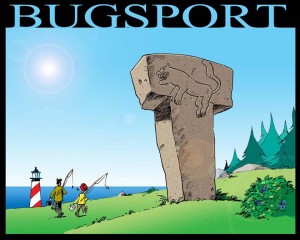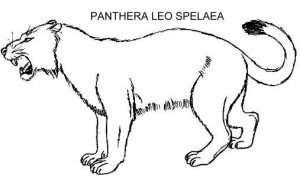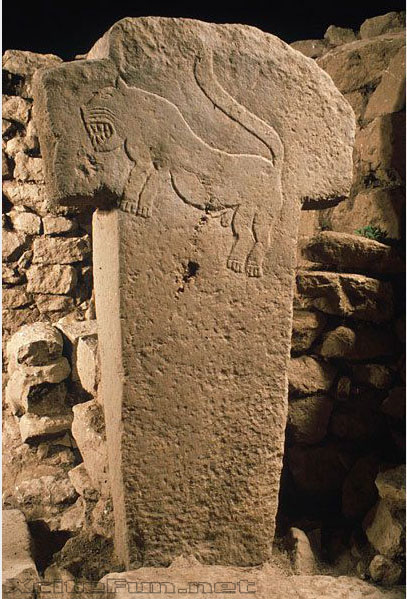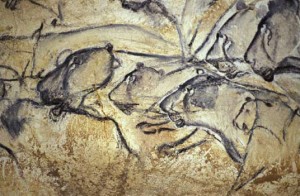New Bugsport: Göbekli Tepe Inspired
Posted by: Loren Coleman on March 22nd, 2012
Ted Bastien of Bugsport fame has drawn a new illustration that he has given me permission to share here. I found it intriguing because of the subject matter on the stone T-pillar that appears out of nowhere, near the shoreline of Maine.

The illustration shows what resembles an Ice Age lion (Panthera atrox? Panthera leo spelaea?) depicted on a megalithic pillar.

Indeed, I asked Ted about what inspired him, and he said Göbekli Tepe. The artist’s inspiration is a specific Neolithic pillar that does show a probable cave lion at Göbekli Tepe. The location and what various images there make for some interesting reading.

Göbekli Tepe [ɡøbe̞kli te̞pɛ] (“Potbelly Hill”) is a Neolithic (stone-age) hilltop sanctuary erected at the top of a mountain ridge in southeastern Anatolia, some 15 kilometers (9 mi) northeast of the town of Şanlıurfa (formerly Urfa / Edessa). It is the oldest known human-made religious structure. The site was most likely erected by hunter-gatherers in the 10th millennium BCE (c. 12,000 years ago) and has been under excavation since 1994 by German and Turkish archaeologists. Together with Nevalı Çori, it has revolutionized understanding of the Eurasian Neolithic.
Many of the pillars are decorated with carved reliefs of animals and of abstract enigmatic pictograms. The pictograms may represent commonly understood sacred symbols, as known from Neolithic cave paintings elsewhere. The reliefs depict lions, bulls, boars, foxes, gazelles, donkeys, snakes and other reptiles, insects, arachnids, and birds, particularly vultures. (At the time the shrine was constructed, the surrounding country was much lusher and capable of sustaining this variety of wildlife, before millennia of settlement and cultivation resulted in the near–Dust Bowl conditions prevailing today.) Vultures also feature prominently in the iconography of the Neolithic sites of Çatalhöyük and Jericho; it is believed that in the early Neolithic culture of Anatolia and the Near East the deceased were deliberately exposed in order to be excarnated by vultures and other carrion birds. (The head of the deceased was sometimes removed and preserved—possibly a sign of ancestor worship.) This, then, would represent an early form of sky burial, as practiced today by Tibetan Buddhists and by Zoroastrians in India.
Few humanoid figures have surfaced at Göbekli Tepe, but they include the engraving of a naked woman posed frontally in a crouched position that Schmidt likens to the Venus accueillante figures found in Neolithic north Africa, and a decapitated corpse surrounded by vultures in bas-relief. Some of the T-shaped pillars picture human arms, which indicate that they represent the bodies of stylized humans (or anthropomorphic gods). The wider stone member atop the T-shaped pillars is thought to symbolize the head; thus the pillars as a whole have an anthropomorphic identity. One example is decorated with human hands in what could be interpreted as a prayer gesture, with a simple stole or surplice engraved above; this may be intended to signify a temple priest.

About Loren Coleman
Loren Coleman is one of the world’s leading cryptozoologists, some say “the” leading living cryptozoologist. Certainly, he is acknowledged as the current living American researcher and writer who has most popularized cryptozoology in the late 20th and early 21st centuries.
Starting his fieldwork and investigations in 1960, after traveling and trekking extensively in pursuit of cryptozoological mysteries, Coleman began writing to share his experiences in 1969. An honorary member of Ivan T. Sanderson’s Society for the Investigation of the Unexplained in the 1970s, Coleman has been bestowed with similar honorary memberships of the North Idaho College Cryptozoology Club in 1983, and in subsequent years, that of the British Columbia Scientific Cryptozoology Club, CryptoSafari International, and other international organizations. He was also a Life Member and Benefactor of the International Society of Cryptozoology (now-defunct).
Loren Coleman’s daily blog, as a member of the Cryptomundo Team, served as an ongoing avenue of communication for the ever-growing body of cryptozoo news from 2005 through 2013. He returned as an infrequent contributor beginning Halloween week of 2015.
Coleman is the founder in 2003, and current director of the International Cryptozoology Museum in Portland, Maine.










I am so glad you wrote about this. My father taught art history and as his child, I endured years of looking at slides of prehistoric art. From everything I have ever learned about prehistoric art, Göbekli Tepe just doesn’t quite fit in. Due to this I have become obessed with it and wish to learn everything that I can. Does anyone else feel that something about this site just isn’t “normal” compared to other similiar sites?
OBOY OBOY! Does this indicate a resumption in the Bugsport story? We’ve really missed the activities in that little town, and all the new Studebaker models, plus we wanna know what F.U.B.A.R. is up to.
DOLLYFINN: I have the same feeling about Göbekli Tepe as a whole, and particularly about the T-shaped pillars winding their way all over the enormous site. The suggestion that they are anthropomorphic is silly – with the skill evidenced in the animal engravings decorating the pillars, I can’t imagine the builders utilizing such a crude shape to represent themselves or their Gods!
I see the pillars as supports for roof members, perhaps a giant serpentine pergola supporting lush vines or cascading plants, leading the people from place to place in the area… there’s many possibilities, and Cryptomundians should take a look at
http://www.google.com/search?q=G%C3%B6bekli+Tepe&hl=en&rls=com.microsoft:en-us:IE-SearchBox&rlz=1I7RNWE_en&prmd=imvns&tbm=isch&tbo=u&source=univ&sa=X&ei=8otrT8njNOjYiAKckZj4BA&ved=0CEMQsAQ&biw=1024&bih=641 for themselves… after all, some of the creatures depicted there are strange, and that makes them cryptids!!
My own theory is that Gobekli Tepe was an ancient zoo and the pillars supported an elevated walkway for observing the animals, which were also depicted on the pillars. The shape of the pillars would make them difficult to climb. I don’t see a temple when I look at it. On Google earth it’s amazing it was ever found… ‘ just another average hillside. There may be hundreds or thousands of sites from that era, waiting to be unearthed. I suspect that rather than being intentionally buried, it was a natural sand and dust accumulator and simply filled in quickly. The significance is the age and the stonework, as always with these places. If it’s from the same age as the original platforms at Baalbeck and Jerusalem, then the level of stonework would seem appropriate for a public wild animal park.
I have a National Geographic with pics of Gobekli Tepe, including some of the beast-reliefs. Boar, crane, foxes, snakes and scorpions. Other beasts such as vultures are noted. On page 38 is a beast that I cannot identify, with some similarities to the supposed Cave Lion but but with a longer snout, no ears and prominent ribs. One of the interesting things about the site is that a vast number of Auroch bones have been found there, and believed to have been brought there from a distance (its been a while since I read the article, but I think this as due to Aurochs not being close enough for the people who ran the temple to hunt. The text on page 48 seems to suggest that the Aurochs were a long ways away.) Auroch bones have been found in other sites as well (oddly at Knossos, a home of the ancient Minoan Bull cult and the myth of the Minotaur), and though they died out a few centuries ago its not impossible that some may still survive somewhere on the globe. They are trying to breed the back now (the breed known as Heck Cattle was such an attempt made by Germans around the time of the 2nd world war).
The Cave Lion identification should be further explored. If they were indeed in that region it would be very, very odd to not have one depicted at the site, so large and powerful an animal…
BTW: here is a pic of that odd animal I wrote about (Hope this works).
http://s2.hubimg.com/u/724517_f260.jpg
Prehistoric “stations of the cross” perhaps? To my mind it would almost have to have some great spiritual context as carving and moving these stones would have taken a great deal of effort at a time when ‘free’ time wasn’t at a premium.
I agree with Fuzzy regarding the likely hood of the ‘t’ being a stand in for the human figure, unless a ‘head’ was once on top of them (it may have been a balanced, carved stone or perhaps made of wood or another material that didn’t stand the test of time) the skill shown in carving the animals would be completely and utterly lacking if these were human figures.
It’s interesting to hear about the vulture tie in. I have to wonder if that is a culture practice they carried with them or if it developed independently as I believe most ancient cultures tended to either bury or burn their dead. Then again, maybe they are the only ones who left evidence behind as an archaeologist or anthropologist would have no way of telling what was natural predation and what was a sky burial as the results would be the same.
I do not think this old depiction is a cave lion, but just a normal lion. In early holocene times lions were present in this region, and given the climate, it´a not probable the lions there had any special traits which were different from those of the the lions in northern Africa or the Near East. Furthermore it could be a stylized leopard as well (without spots), as leopards were even present in some regions of Turkey lesser than a century ago, and several thousand years ago, they were even more wide-spread, and in some areas even tigers were still present in historic times.